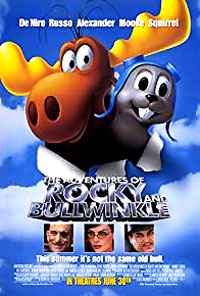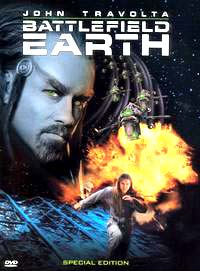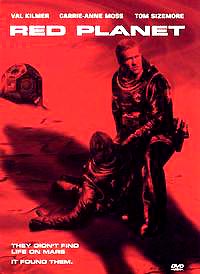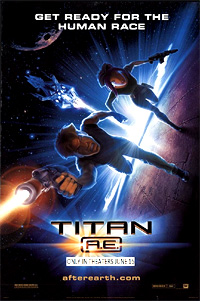
|
|
(chronologically, by film title) Intro | Summary Chart | Silents-1949 | 1950 -1966 | 1967-1969 | 1970-1974 | 1975-1977 | 1978-1979 1980 | 1981 | 1982 | 1983-1984 | 1985-1986 | 1987-1989 1990-1991 | 1992-1994 | 1995 - 1 | 1995 - 2 | 1996-1997 | 1998 | 1999 | 2000 | 2001 - 1 | 2001 - 2 2002 - 1 | 2002 - 2 | 2002 - 3 | 2003 | 2004 | 2005 | 2006 | 2007-2011 | 2012-2014 | 2015-2017 | 2018-2019 | 2020-2021 |
|
| Film Title, Director, Studio, Budget Information, Description | |

|
The Adventures of Rocky & Bullwinkle (2000) Director: Des McAnuff Studio/Distributor: Capella International Budget: $76-98.6 million Domestic Gross: $26 million Worldwide Gross: $35.1 million Total Net Loss: $63.5 million Total Estimated Loss (Inflation-Adjusted): $100 million |

|
Battlefield Earth: A Saga of the
Year 3000 (2000) Headlining star John Travolta (a devoted member and spokesperson for Scientology), following his revived career success with Pulp Fiction (1994) (and other hits including Get Shorty (1995) and Face/Off (1997)), promoted this unappealing film turkey into production over almost two decades. It was a questionable adaptation of Scientologist founder L. Ron Hubbard's 1980 propagandistic science fiction novel (of over 800 pages) of the same name first published in 1982 (and adapted and scripted by screenwriters Corey Mandell and J.D. Shapiro). It was mostly derivative of the grubby dystopic look of previous films, such as Blade Runner (1982) and The Postman (1997), as well as Planet of the Apes (1968) and John Carpenter's Escape From New York (1981) and Escape From L.A. (1996) - and then mixed with prehistoric man films, such as One Million Years B.C. (1966) starring Raquel Welch, Caveman (1981) with Ringo Starr, and Quest for Fire (1981). This horribly boring film marked the directing debut of Roger Christian. It was set in the year 3000 and told about alien captors named Psychlos (from the planet Psychlo) who had conquered the Earth and virtually destroyed it by plundering its mineral-gold resources through strip-mining. Travolta starred as Terl -- an unkempt, snot-nosed, matt-haired, ruthlessly exploitative, 9-foot tall alien with awful teeth -- similar in appearance to a homeless Star Trek Klingon, who was the greedy chief security officer for the Psychlos' greenhouse-domed mining operations (over the city of Denver). Terl was commissioned to supply the 'home-office' with a quota of gold. The protagonist of the film was rebellious man-animal survivor and captive Jonnie Goodboy Tyler (Barry Pepper) who revolted against his enslavement while sent to retrieve gold from a ruined Fort Knox. The comic-bookish film became popularly reviled and scorned along the same thematic lines of its 'bad-movie' predecessor, Showgirls (1995) -- for its ludricrous and dumbly incoherent plot, incompetent editing, camp appeal, cliched dialogue, faulty and ugly special effects, excessive tilt-angled and slow-motion camera shots, an unusual "center wipe" transitional editing device, a loud and obnoxious soundtrack, and thinly-drawn characters. It played more like a bad TV movie about space invaders than a $73 million dollar blockbuster, and quickly bombed at the box-office. In the year 2000, Travolta was insisting, incredulously, that there be a sequel (since the film was based on only the first half of Hubbard's book.) It won seven of its eight Razzie Award nominations, including Worst Actor (Travolta), Worst Director, Worst Picture, Worst Screen Couple, Worst Screenplay, Worst Supporting Actor (Barry Pepper), and Worst Supporting Actress (Travolta's real-life wife Kelly Preston, as alien babe Chirk with an elongated tongue that rolled up like a window shade), with an additional nomination for Worst Supporting Actor (Forest Whitaker as Terl's sidekick). It also won the 2005 Razzie Award for Worst 'Drama' in the Razzie's 25 year history, defeating Mommie Dearest (1981), The Lonely Lady (1983), Showgirls (1995) and Swept Away (2002). |

|
Red Planet (2000) The only film ever directed by Antony Hoffman, this space-adventure, science-fiction thriller was taglined: "They Didn't Find Life on Mars. It Found Them" - starring Val Kilmer and Carrie-Anne Moss (fresh off her role in The Matrix (1999)). It was partially confused with another similar competing film titled Mission to Mars released earlier in the year, and was forced to change its original title from Mars to Red Planet. Set in the mid-21st century, it told the familiar, formulaic and banal tale of a rescue mission by Mars-1, headed up by Commander Kate Bowman (Carrie-Anne Moss), to help save the Mars Terraforming Project, created to start a new habitable civilization on the red planet because the polluted and overpopulated Earth was on the verge of ecological devastation. Suddenly the algae disappeared and oxygen levels were unmeasurable. After their journey, the landing craft crash-landed (the crew included engineer Robby Gallagher (Val Kilmer), pilot Ted Santen (Benjamin Bratt) and two scientists (Tom Sizemore and Terence Stamp)), and the orbiting ship with Bowman also suffered various system failures. Stranded and without communications, the landing party was also being attacked by their own damaged military robot named AMEE - their Mars surface navigator (with two modes, "scientific" and "military" - the latter causing the most trouble). Almost by rote prediction, there were all the usual but unexpected catastrophes and dangers, as the characters were eliminated one by one, while only a few survived by the film's end. Some of the film's scientific inconsistencies included the planet's ice-storm and the voracious bugs feeding off the growing algae. The big-budget film was criticized for being poorly executed and mostly dull and mediocre (with philosophical discussions about science vs. faith enroute for six months to Mars). It lacked pacing (the script by Chuck Pfarrer was extremely slow-moving) and its disjointed themes all competed against one other. Simplified characterizations were evident in the opening credits voice-over, short-cutting the process of providing actual dramatization. Its domestic and foreign grosses were about equal, totaling only $33.5 million, although its production budget was a whopping $80 million. |

|
Supernova (2000) This science-fiction horror film, with a troubled production history, was the first (and last) film of frustrated director Walter Hill, who was credited with the name 'Thomas Lee' for the film. ['Thomas Lee' replaced the pseudonym 'Alan Smithee' as an indication that the real director disowned the film and didn't want to be identified.] Reportedly, MGM shelved the film after its making, and a year later, Francis Ford Coppola was summoned to re-edit and recut the film. It was considered similar in plot to Event Horizon (1997) and Hellraiser (1987, UK). The mediocre box-office bomb, with a very slight box-office gross of about $15 million, was widely criticized by reviewers (who were not allowed pre-screenings) for its cliched, incoherent and illogical storyline, derivative sci-fi premise (similar to Alien (1979)), extensive dialogue and techno-babble exposition (about dimensional warps, jumps and transfers in pods that required the crew to disrobe!), weak special effects, and lack of chemistry among its stars. The predictable action film told about the threat of a 9th-dimensional bomb in the early 22nd century, with a tagline that was appropriate for the studio after the film failed miserably: "In the farthest reaches of space, something has gone terribly wrong." The plot was about a medical rescue team, an intersellar spaceship-ambulance (Nightingale 229) patroling deep space awaiting emergency calls. Its six-member crew was composed of Tom and Jerry cartoon-watching Captain A.J. Marley (Robert Forster), recovering drug addict/co-pilot Nick Vanzant (James Spader), medical officer Dr. Kaela Evers (Angela Bassett), the sex-crazed couple: medical technician Yerzy Penalosa (Lou Diamond Phillips) search and rescue paramedic Danica Lund (Robin Tunney), and gay computer technician Benjamin Sotomejor (Wilson Cruz) who was in love with the flirty "female" computer named Sweetie (voice of Vanessa Marshall). They received a distress signal from a group of workers involved in an ice mining operation on the remote rogue moon Titan 37, over 3,000 light years away. Titan 37 orbited a huge blue star (with an intense gravity pull) that was about to explode into a supernova. During an attempted rescue (with a damaged ship), they picked up Karl Larson (Peter Facinelli), a disturbing and menacing superhuman mutant who had smuggled onboard (in a glowing case!) a strange, phallic-like alien artifact (containing 9th dimensional matter). |

|
Titan A.E. (2000) Fox Animation Studios' second theatrical feature (following Anastasia (1997), also directed by Don Bluth) was an abysmal failure, although it was a dazzling hybrid of traditional 2D cel animation and CGI. The reasons for its demise included a change of director (after 18 months), cost over-runs during pre-production, budget constraints, a short time-line, and a decision to end the costly 2D animation part-way through production. Titan A.E. also faced competition when Disney released Fantasia (2000) for an exclusive IMAX showing at the same time, while two other films also hurt its prospects: Shaft (2000) with Samuel L. Jackson, and the dramedy Boys and Girls (2000) with Freddie Prinze, Jr. and Claire Forlani. The next week, the releases of Chicken Run (2000) and Me, Myself and Irene (2000) further doomed its prospects. Due to its poor box-office showing, Fox was forced to close its large Phoenix, Arizona animation studio (and fire many animator-employees) after only two feature films. There were some achievements for the miscalculating film, however. It was the first major Hollywood film to be publicly preview-screened via the Internet (digital transmission), when shown in Atlanta in early June of 2000. It was Bluth's last animated film, and the first PG-rated Bluth animation as well. The space opera's title referred to a space station (named Titan) and A.E. signified "After Earth." The setting for the sci-fi animated saga was the futuristic year of 3028, after Earth had been destroyed by an invading, energy-based alien species (known as the Drej). One of the nomadic survivors after Earth's obliteration, teenaged Cale Tucker (voice of Matt Damon), possessed a map in a ring (given to him by his father) to guide him to Titan, a hidden space-station refuge located in the Andali Nebula. His quest was to find Titan and the fabled Ice Planet, with spaceship captain Joseph Korso (voice of Bill Pullman), pretty female pilot Akima (voice of Drew Barrymore), and an alien crew: Preed (Nathan Lane), Gune (John Leguizamo), and Stith (Janeane Garofalo). |